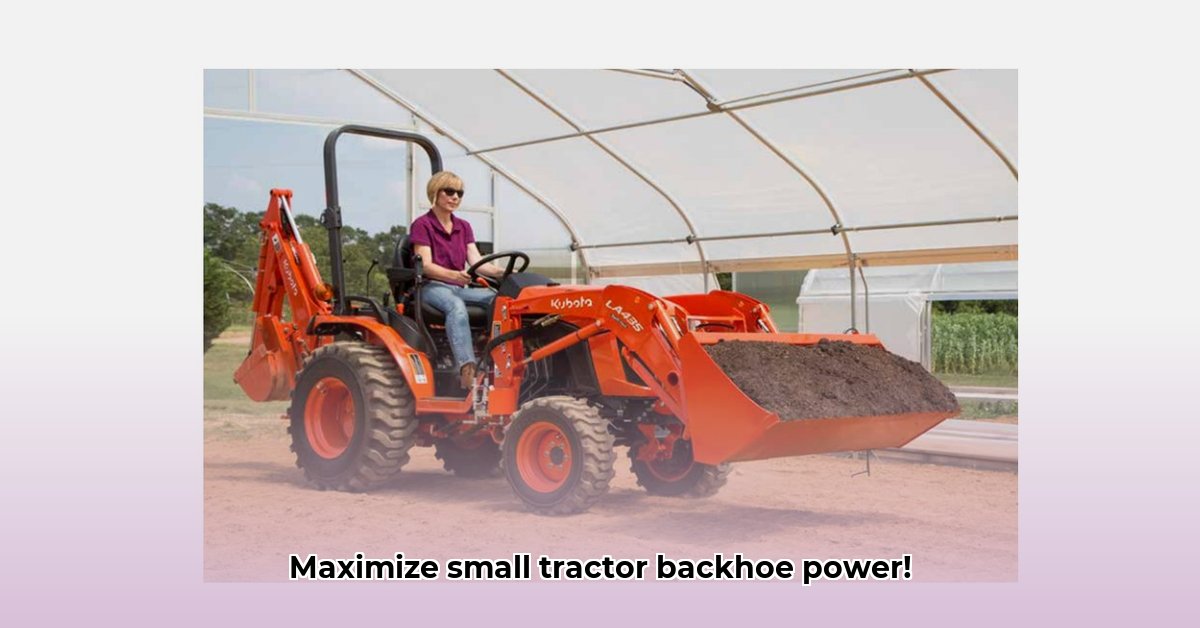
Choosing the Right Small Tractor Backhoe: A Sustainable Farming Approach
Selecting the right small tractor backhoe is a significant investment impacting both your farm's productivity and its environmental footprint. This guide provides a step-by-step approach to ensure you choose a machine that optimizes efficiency and aligns with sustainable farming practices. Don't underestimate the long-term implications of this decision; the right backhoe can significantly impact your farm's bottom line and its environmental impact. For more detailed information on backhoes, check out this helpful resource: Backhoe Selection Guide.
Assessing Your Farm's Unique Needs
Before exploring specific models, thoroughly assess your farm's characteristics. Consider the following:
- Acreage: How many acres do you manage? This dictates the maneuverability and power requirements of your backhoe.
- Soil Type: Sandy, clay, or rocky soil impacts the necessary backhoe strength and digging capabilities. Heavier soils require more powerful machines.
- Terrain: Hilly terrain demands a more agile and powerful machine than flat land. Consider the grade and potential for erosion.
- Typical Tasks: What tasks will the backhoe primarily perform? (e.g., digging post holes, trenching, material handling). This informs your attachment needs.
A thorough needs assessment ensures you invest in a machine suited to your specific context, avoiding unnecessary expense and environmental impact from an oversized or underpowered machine. How will a precise assessment of your needs improve your overall farm efficiency?
Key Features and Specifications: Maximizing Efficiency and Sustainability
Once you understand your needs, focus on these crucial specifications:
- Horsepower: Higher horsepower generally means increased lifting capacity and digging speed. However, it also increases fuel consumption. Find the optimal balance between power and fuel efficiency. What horsepower is best for your acreage and soil conditions?
- Fuel Efficiency: Prioritize models with proven fuel-efficient engines. Consider engine type (diesel is often more fuel-efficient for agricultural use) and transmission type (hydrostatic transmissions can enhance efficiency). Lower fuel consumption reduces operational costs and environmental impact.
- Attachments: A versatile backhoe with a range of compatible attachments (e.g., front loader, tiller, grapple) significantly increases its utility and reduces the need for multiple pieces of equipment. What attachments are essential for maximizing your backhoe's efficiency on your farm?
- Maintenance Accessibility: Factor in the ease of maintenance and repair. Easy access to components and readily available parts minimize downtime and repair costs.
The right combination of power, fuel efficiency, and versatility allows for efficient operations while minimizing the environmental footprint of your farm.
Long-Term Planning: Maintenance and Financial Considerations
Investing in a small tractor backhoe is a significant financial commitment. Carefully consider these aspects:
- Purchase vs. Lease: Weigh the pros and cons of buying versus leasing. Leasing can reduce upfront costs, but buying offers long-term ownership and potential resale value.
- Maintenance Budget: Allocate funds for regular maintenance (oil changes, filter replacements, etc.) to prevent costly breakdowns and extend the machine's lifespan. How much should you budget annually for maintenance to ensure long-term operational efficiency?
- Repair Accessibility: Ensure access to reliable repair services and readily available parts in your area to minimize downtime in case of unexpected issues.
- Return on Investment (ROI): Project the backhoe's impact on your farm's efficiency and profitability. Will the increased productivity offset the initial investment and ongoing maintenance costs?
Strategic financial planning ensures the backhoe remains a valuable asset, contributing to long-term farm profitability and sustainability.
Risk Assessment Matrix:
| Risk Factor | Likelihood | Potential Impact | Mitigation Strategies |
|---|---|---|---|
| High Purchase Cost | High | Significant Financial Strain | Explore financing or leasing; consider used equipment; investigate shared ownership opportunities. |
| Mechanical Breakdown | Medium | High Downtime, Repair Costs | Regular preventative maintenance; service contracts; establish relationships with local mechanics. |
| Soil Compaction | Medium | Reduced Soil Health, Crop Yields | Use appropriate tillage practices; monitor soil health; consider the machine's weight on your soil. |
| Environmental Concerns | Low | Negative Environmental Impact | Choose fuel-efficient models; explore alternative fuels; participate in carbon offsetting programs. |
This matrix helps you proactively address potential challenges associated with owning a small tractor backhoe.
Sustainable Practices: Minimizing Your Environmental Impact
Sustainable farming practices are crucial. Consider these points when choosing your backhoe:
- Fuel Efficiency: Prioritize models with low fuel consumption to reduce greenhouse gas emissions and operational costs.
- Emission Controls: Choose machines that meet or exceed environmental regulations for emissions.
- Responsible Disposal: Plan for responsible disposal or recycling of the backhoe at the end of its lifespan.
Prioritizing sustainability minimizes your farm's environmental footprint and contributes to a healthier planet.
Actionable Steps for Choosing Your Backhoe:
- Thoroughly assess your farm's needs.(as described above)
- Research different models and brands. Compare specifications, read reviews, and compare fuel efficiency ratings.
- Visit local dealerships. Discuss your needs with experienced sales staff and obtain quotes.
- Test drive different models. This provides hands-on experience with the machine's operation and maneuverability.
- Develop a detailed budget. Include purchase price, maintenance, repairs, and fuel costs.
- Make an informed decision. Choose the model that best fits your farm's unique requirements, budget, and commitment to sustainable agriculture.
By following these steps, you can ensure your investment in a small tractor backhoe maximizes efficiency, minimizes environmental impact, and contributes to the long-term success of your sustainable farming operation. Remember Dr. Amelia Hernandez, Agricultural Engineer at the University of California, Davis, emphasizes that "the right equipment investment is a long-term commitment to your farm's future."